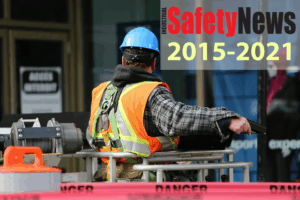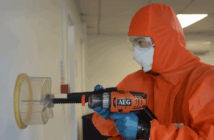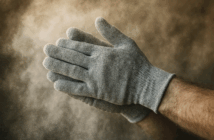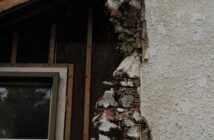Inhalation of dust at work may result in serious lung disease, often not recognised or diagnosed until many years later. Stopping dust circulating in the workplace must be a priority

Breathing in dust can cause a number of health conditions, including pneumoconioses (such as silicosis), lung cancer, asthma and chronic obstructive pulmonary disorder (COPD). Many controls exist to minimise the exposure to construction dusts in the workplace, including dust extraction, water suppression and personal protective equipment (PPE).
In a Worksafe study of construction workers in Waikato, New Zealand (n=250), construction workers were asked about their use of dust control practices and their consideration of the risks from construction dusts.
The study had several key findings:
- Low use of dust suppression and extraction was reported, particularly for demolition and woodwork
- Low use of controls was reported for clean-up processes
- High levels of respirator use were reported, but users were rarely clean shaven and had low levels of fit testing
- The provision of health monitoring for workers was also very rare
- Younger workers were also less likely to consider the risks to their health and less likely to use respiratory protection.
Click here for the full report
Controlling dust with on-tool extraction
Some of the most common construction and manufacturing jobs create high levels of dust. These jobs often involve the use of power tools like cut-off saws, grinders, polishers, breakers and sanders.
As a PCBU, you have a duty to eliminate, or use controls to minimise, worker exposure to the hazard of, and risks from, dust. Upstream PCBUs have a duty to ensure the equipment they design, manufacture, import or supply is safe for users.
On-tool extraction is a type of local exhaust ventilation (LEV) system which is fitted directly onto the tool.
The system has several parts:
- the tool
- captor hood
- extraction unit, and
- hoses
Each part is critical to the system’s effectiveness and level of dust control.
Complete on-tool extraction systems are available but some parts (especially extraction units) can be used with other tool makes and models.
For effective dust control, it’s important to choose parts that are compatible. Involve workers in selecting a system that’s right for the task.
Click here for more information and guidance from WorkSafe
Wood dust
Wood processing causes small particles of wood dust to become suspended in the air. Workers can inhale these particles. A person’s upper respiratory system can filter out the larger particles, but smaller particles can go deep into the lungs causing damage and scarring to the lung tissue. Each time this happens a small amount of irreversible damage occurs. This damage reduces the lungs’ ability to take in oxygen and over time makes it increasingly difficult to breathe.
The presence of glues, resins, formaldehyde and other wood treatment chemicals in some wood products increase the health risks from wood dust.
Talks that can be delivered at your workplace:
Click here for more information and guidance from WorkSafe
Safe manufacturing and use of synthetic mineral fibre products
Because of their similar application and appearance to asbestos, there has been concern about the health effects associated with exposure to synthetic mineral fibres (SMF). Concern in recent years as to the
possible respiratory health hazards of SMF has lead to a number of comprehensive studies world-wide seeking to clarify the position.
SMF include materials like fibreglass, rockwool, and ceramic fibres. These are commonly used for insulation and can be hazardous if the tiny particles are inhaled, enter skin or get into the eyes.
There is a risk to the health of workers who make or install synthetic mineral fibre products, particularly if the fine dust is inhaled.
It seems prudent not to regard SMF as simply a nuisance dust but rather as a potential hazard which requires sensible and appropriate precautions.
Health and safety guidelines for the selection and safe handling of synthetic mineral fibres describes safe working methods when manufacturing or using synthetic mineral fibre products including respiratory protective equipment, protective clothing and health monitoring.
Click here for more information and guidance from WorkSafe
Silica dust
Inhalation of very fine dust containing crystalline silica (respirable crystalline silica or RCS) can lead to silicosis, a serious irreversible and progressive lung disease.
Silica is a natural substance found in concrete, bricks, rocks, stone (including artificial or engineered stone kitchen benchtops), sand and clay. RCS dust is created when materials containing silica are cut, ground, drilled, sanded, polished or otherwise disturbed. The dust is not necessarily visible to the naked eye, so is more difficult to control.
Key things that can be done to minimise the risks of silica dust are:
- Use natural stone like marble and limestone. These have a much lower silica content than engineered/artificial stone (as low as 2% compared to 90%).
- Control dust by wetting work materials, work processes and work areas with fine water mist and using an H-class HEPA-filtered vacuum cleaner when cleaning up.
- Choose equipment and machinery with good dust control and dust collection systems. If in doubt, contact the manufacturer.
- Schedule potential high-exposure work for times when there are fewer workers and others around (eg breaks or after normal working hours).
- Schedule potential high-exposure work for times when there are fewer workers and others around (eg breaks or after normal working hours).
- Provide PPE (eg overalls, gloves and suitable respiratory (breathing) protection) in accordance with the Standards and ensure workers know how to wear, use and store it correctly. Ensure workers are fit tested for any respirator they wear that requires a seal against the face.
- Wear, use and store PPE correctly and let the business know if it no longer works (eg if it no longer fits properly or is broken). When wearing a respirator that requires a seal against the face, you must be clean shaven to ensure it fits properly.
- Leave dust-covered work clothes at work to be cleaned. Do not wear them home.
- Wash hands before eating, drinking or smoking. Wash up before leaving work at the end of the day.
Click here for more information and guidance from WorkSafe
Accelerated silicosis
While many diseases linked to dust and RCS dust exposure are slow to develop and may not show significant symptoms for up to 20 years after exposure, in acute cases, symptoms can show within a year.
Accelerated silicosis develops over a short period (5 to 10 years) from inhalation of very high concentrations of RCS. As of February 2019, 99 confirmed cases of silicosis associated with engineered stone benchtop work have been identified in Queensland, Australia. The vast majority of the workers had no symptoms of the disease, but were diagnosed by medical tests, including CT scans. This also follows concerns for New Zealand stonemasons.



